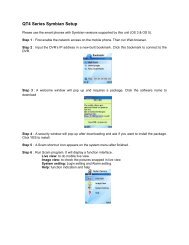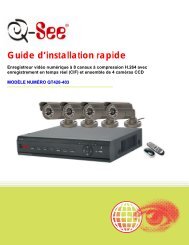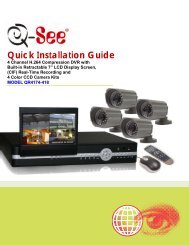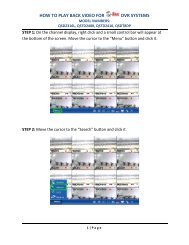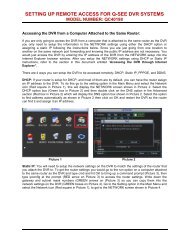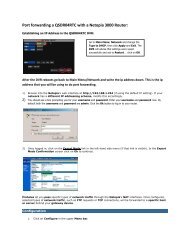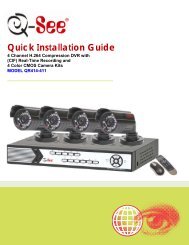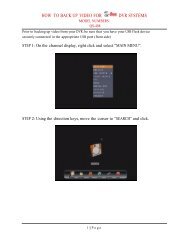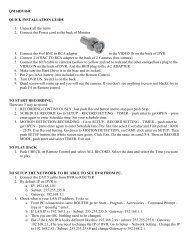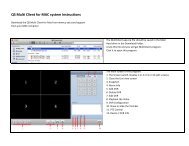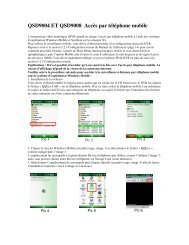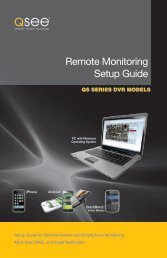User Manual - Q-See
User Manual - Q-See
User Manual - Q-See
Create successful ePaper yourself
Turn your PDF publications into a flip-book with our unique Google optimized e-Paper software.
PLAYBACK<br />
Once you have completed your search, you are ready to play back your files. The controls on<br />
the Search and Playback Interface operate like any other video playback software.<br />
In addition, you can advance the playback to a certain point in the record by clicking on, and<br />
sliding the progress indicator.<br />
Button Function Note<br />
Play / Pause<br />
Stop<br />
PICTURE 6-15<br />
At the top of the file visualizer, the bar represents the time when the file was recorded. Clicking<br />
on this will magnify it to show minutes allowing a more precise search.<br />
Reverse<br />
Previous Section<br />
Only functional when playing back in single channel mode.<br />
NOTE! Clicking on any channel in multi-screen playback will switch the display<br />
to a single-channel view of that feed. Click again to return to the previous<br />
playback mode.<br />
Next Section<br />
Previous Frame.<br />
Next Frame.<br />
Only functional when playing back in single channel and in<br />
Pause mode.<br />
By default, the system will begin playing back the recording from Channel 1 when the Play<br />
button is pressed.<br />
Selecting a Screen Display Mode button<br />
above the file list will open a pop-up window<br />
allowing you to select which channel(s) to<br />
play back. Only the screen display mode<br />
buttons appropriate to your card will be<br />
offered as options. Buttons allowing you to<br />
select specific groups of channels will appear<br />
depending on your card’s capabilities. Click<br />
OK to return to the Playback window.<br />
During playback, you can adjust the speed<br />
of the recording with the slider located at the<br />
bottom of the interface.<br />
PICTURE 6-13<br />
PICTURE 6-14<br />
6.5 OTHER FUNCTIONS<br />
Other functions within this interface allow you to back up files, capture still images, print<br />
images and digitally zoom in on a recording.<br />
FILE BACKUP<br />
Clicking on the file icon allows you to back up your files to another drive for use<br />
elsewhere or simply to preserve them without having to worry about them being<br />
overwritten by the Recycling Record function.<br />
The Backup window operates much like the<br />
Record Search window and it is divided into<br />
four main areas:<br />
A: Camera Selection Area - Select which<br />
cameras’ recordings you wish to back up.<br />
B: Time and Date Selection Area - Select<br />
the start and end dates and times for the<br />
records you wish to back up.<br />
C: Operation Area - Select the save path<br />
for the backup files. You can also choose to<br />
save a standalone playback program to allow<br />
others to view the files.<br />
D: Information Area - The program will use<br />
this area for any warnings or notices.<br />
Click Start to begin backing up your files.<br />
PICTURE 6-16<br />
CHAPTER 6 RECORDING, PLAYBACK AND RECORD SEARCH<br />
30 31




